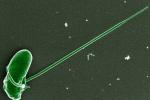A photosynthetic alveolate closely related to apicomplexan parasites
Oborník M., Janouškovec J., Chrudimský T., Vancová M.
Many parasitic apicomplexans, such as for instancePlasmodium falciparum, the causative agent of malaria, or teratogenic parasite Toxoplasma gondii, contain a non-photosynthetic relic plastid also called the apicoplast, which represents a prospective target for malaria treatment. However, no close relative of apicomplexans with a functional photosynthetic plastid has yet been described. Here we describe a new organism isolated from corals that has ultrastructural features typical for alveolates, is phylogenetically related to apicomplexans, and contains a photosynthetic plastid. The plastid is surrounded by four membranes, is pigmented by chlorophyll a, and uses the codon UGA to encode tryptophan in the psbA gene. This genetic feature has been found only in coccidian apicoplasts and various mitochondria. The UGA-Trp codon and phylogenies of plastid and nuclear ribosomal RNA genes indicate that the organism is the closest known photosynthetic relative to apicomplexan parasites and that its plastid shares an origin with the apicoplasts. The discovery of this organism provides a powerful model for studying the evolution of parasitism in Apicomplexa.














